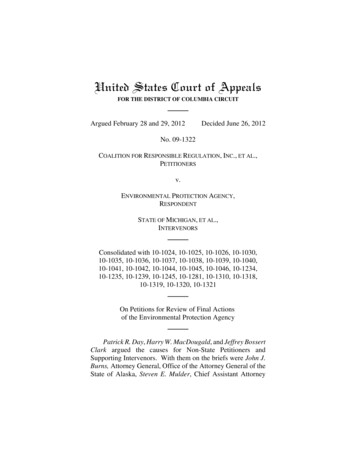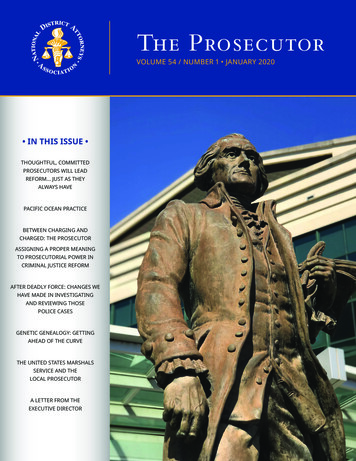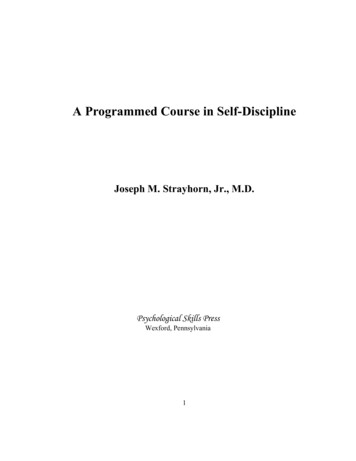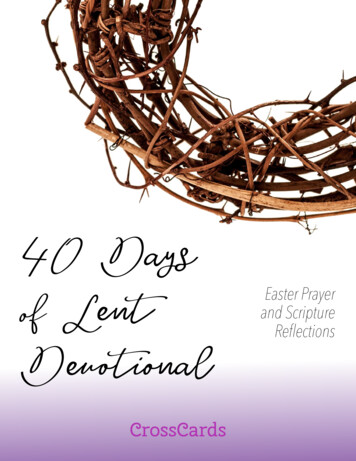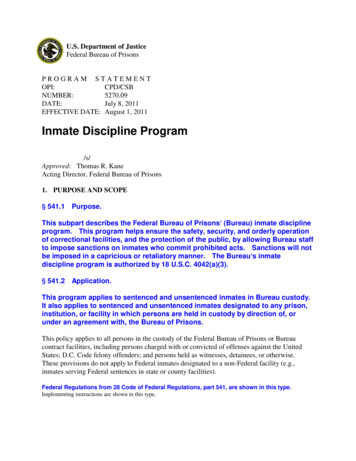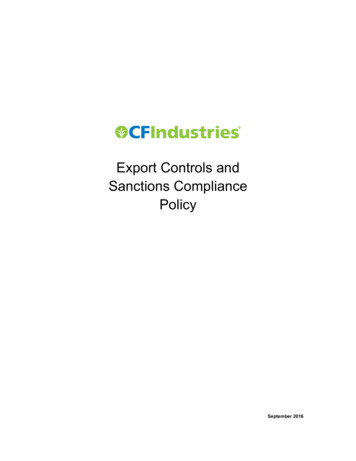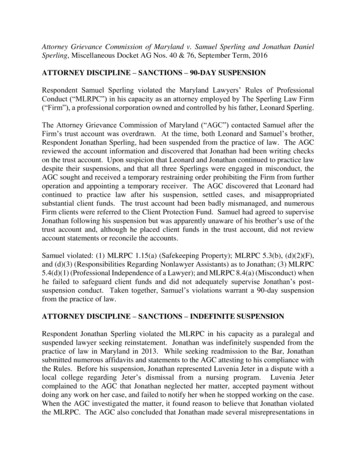
Transcription
Attorney Grievance Commission of Maryland v. Samuel Sperling and Jonathan DanielSperling, Miscellaneous Docket AG Nos. 40 & 76, September Term, 2016ATTORNEY DISCIPLINE – SANCTIONS – 90-DAY SUSPENSIONRespondent Samuel Sperling violated the Maryland Lawyers’ Rules of ProfessionalConduct (“MLRPC”) in his capacity as an attorney employed by The Sperling Law Firm(“Firm”), a professional corporation owned and controlled by his father, Leonard Sperling.The Attorney Grievance Commission of Maryland (“AGC”) contacted Samuel after theFirm’s trust account was overdrawn. At the time, both Leonard and Samuel’s brother,Respondent Jonathan Sperling, had been suspended from the practice of law. The AGCreviewed the account information and discovered that Jonathan had been writing checkson the trust account. Upon suspicion that Leonard and Jonathan continued to practice lawdespite their suspensions, and that all three Sperlings were engaged in misconduct, theAGC sought and received a temporary restraining order prohibiting the Firm from furtheroperation and appointing a temporary receiver. The AGC discovered that Leonard hadcontinued to practice law after his suspension, settled cases, and misappropriatedsubstantial client funds. The trust account had been badly mismanaged, and numerousFirm clients were referred to the Client Protection Fund. Samuel had agreed to superviseJonathan following his suspension but was apparently unaware of his brother’s use of thetrust account and, although he placed client funds in the trust account, did not reviewaccount statements or reconcile the accounts.Samuel violated: (1) MLRPC 1.15(a) (Safekeeping Property); MLRPC 5.3(b), (d)(2)(F),and (d)(3) (Responsibilities Regarding Nonlawyer Assistants) as to Jonathan; (3) MLRPC5.4(d)(1) (Professional Independence of a Lawyer); and MLRPC 8.4(a) (Misconduct) whenhe failed to safeguard client funds and did not adequately supervise Jonathan’s postsuspension conduct. Taken together, Samuel’s violations warrant a 90-day suspensionfrom the practice of law.ATTORNEY DISCIPLINE – SANCTIONS – INDEFINITE SUSPENSIONRespondent Jonathan Sperling violated the MLRPC in his capacity as a paralegal andsuspended lawyer seeking reinstatement. Jonathan was indefinitely suspended from thepractice of law in Maryland in 2013. While seeking readmission to the Bar, Jonathansubmitted numerous affidavits and statements to the AGC attesting to his compliance withthe Rules. Before his suspension, Jonathan represented Luvenia Jeter in a dispute with alocal college regarding Jeter’s dismissal from a nursing program. Luvenia Jetercomplained to the AGC that Jonathan neglected her matter, accepted payment withoutdoing any work on her case, and failed to notify her when he stopped working on the case.When the AGC investigated the matter, it found reason to believe that Jonathan violatedthe MLRPC. The AGC also concluded that Jonathan made several misrepresentations in
his efforts to gain readmission to the Bar following his suspension in 2013, in violation ofthe MLRPC.Jonathan violated: (1) MLRPC 5.3(d)(3) (Responsibilities Regarding NonlawyerAssistants); (2) MLRPC 8.1(a) (Bar Admission and Disciplinary Matters); and (3) MLRPC8.4 (a), (c) and (d) (Misconduct) when he failed to comply with his obligations as asuspended lawyer working in a law firm and made misrepresentations during hissuspension and in his efforts to gain readmission to the Bar. Taken together, theseviolations warrant continuing his indefinite suspension.
Circuit Court for Baltimore CountyCase No.: 03-C-16-010146Argued: March 5, 2018IN THE COURT OF APPEALSOF MARYLANDMisc. Docket AG Nos. 40 and 76September Term, 2016ATTORNEY GRIEVANCE COMMISSIONOF MARYLANDv.SAMUEL SPERLING andJONATHAN DANIEL SPERLINGBarbera, n by Adkins, J.Greene and Watts, JJ., concur and dissent.Filed: May 21, 2018
In 2016, the Attorney Grievance Commission of Maryland (“AGC”), acting throughBar Counsel, filed a Petition for Disciplinary or Remedial Action (“Petition”) againstRespondents Samuel Sperling and Jonathan Daniel Sperling.1 The AGC’s investigationbegan in 2014 after it received notice that The Sperling Law Office, P.C.’s (“Firm”) trustaccount was overdrawn.2Bar Counsel charged Samuel with violating the Maryland Lawyers’ Rules ofProfessional Conduct3 (“MLRPC”) in his capacity as an attorney working at the SperlingLaw Office, P.C. (“Firm”).Specifically, Bar Counsel alleged that Samuel violatedMLRPC: (1) 1.15(a) and (d) (Safekeeping Property); (2) 5.3(a)–(d) (ResponsibilitiesRegarding Nonlawyer Assistants); (3) 5.4(a) and (d) (Professional Independence of aLawyer); (4) 5.5(a) (Unauthorized Practice of Law; Multijurisdictional Practice of Law);(5) 8.1(a) and (b) (Bar Admission and Disciplinary Matters); and (6) 8.4(a)–(d)(Misconduct).Bar Counsel charged Jonathan with violating MLRPC: (1) 1.1 (Competence); (2)1.2(a) (Scope of Representation and Allocation of Authority Between Client and Lawyer);(3) 1.3 (Diligence); (4) 1.4(a)–(b) (Communication); (5) 1.5(a)–(b) (Fees); (6) 1.16(d)1For clarity, the Sperlings will hereinafter be referred to by their first names.2The Attorney Grievance Commission filed a separate Petition for Disciplinary orRemedial Action against Jonathan in 2017, stemming from a complaint filed by LuveniaJeter, a former client of Jonathan’s. By Order of this Court, the matters were consolidated.Effective July 1, 2016, the MLRPC were renamed the Maryland Attorneys’ Rulesof Professional Conduct (“MARPC”) and renumbered. Rules Order (June 6, 2016). Therevised rules are now numbered as follows: MARPC 19-301.1, et. seq. We will refer tothe MLRPC because the misconduct at issue occurred before this change.3
(Declining or Terminating Representation); (7) 5.3(d)(3) (Responsibilities RegardingNonlawyer Assistants); (8) 8.1(a)–(b) (Bar Admission and Disciplinary Matters); and (9)8.4(a)–(d) (Misconduct).We transmitted the matter to the Honorable H. Patrick Stringer (“the hearing judge”)of the Circuit Court for Baltimore County to hear the case. Following a five-day hearing,the hearing judge issued Findings of Fact and Conclusions of Law, in which he found byclear and convincing evidence that Samuel violated MLRPC 1.15, 5.3(b) and (d)(3),5.4(d)(1), and 8.4(a). The hearing judge also concluded that Jonathan violated MLRPC5.3(d)(2)(G) and (d)(3), 8.1(a), and 8.4(a) and (c), and Maryland Rules 16-760(c)(11),(d)(3), and 16-609(b).4THE HEARING JUDGE’S FINDINGS OF FACTSamuel was admitted to the Maryland Bar in 1996, and Jonathan was admitted in1998. Upon admission, both brothers began working as associates at a law firm operatedas a sole proprietorship by their father, Leonard Sperling (“Leonard”). In March 2004, theCourt of Appeals suspended Leonard from the practice of law.5 During his suspension,The Sperling Law Office, P.C. was formed. The Articles of Incorporation identify Samuelas the incorporator, and Samuel and Jonathan as the initial directors. The hearing judgefound that there was no evidence that Samuel and Jonathan remained as directors or served4Maryland Rules 16-760 and 16-609 have since been amended and renumbered asMd. Rules 19-742 and 19-410 respectively.5Attorney Grievance Comm’n v. Sperling, 380 Md. 180 (2004).2
as officers of the Firm beyond the initial formation. At the same time, the Firm alsoestablished an attorney trust account. Leonard, Samuel, and Jonathan were the onlyattorneys with signatory authority on the trust account.Leonard was reinstated in July 2004 and resumed practice at the Firm. The hearingjudge found that Leonard was the sole shareholder, and he ran the firm, including“managing the attorney trust account, assigning cases, settling cases, paying bills[,] andhandling the payroll.”In July 2013, Jonathan was indefinitely suspended from the practice of law. 6 Hewas represented by Robert Hesselbacher, who continued advising Jonathan after hissuspension about compliance with the Rules and reinstatement requirements.7Hesselbacher met with Jonathan, Samuel, and Leonard to discuss the limitations onJonathan’s activities as a suspended attorney. On July 10, 2013, the Firm employedJonathan as a paralegal.In September 2013, Leonard was indefinitely suspended from the practice of law.8His suspension became effective in October 2013. At that time, there were three licensedattorneys working at the Firm: Samuel, Andrea Babest, and Michele Loewenthal. Leonardcontinued to work at the Firm following his suspension. In April 2014, Jonathan filed a6Attorney Grievance Comm’n v. Sperling, 432 Md. 471 (2013).7Robert Hesselbacher also represented and advised Leonard regarding compliancewith the Rules following Leonard’s suspension.8Attorney Grievance Comm’n v. Sperling, 434 Md. 658 (2013).3
Petition for Reinstatement, which Bar Counsel opposed. The Court of Appeals deniedJonathan’s reinstatement in July 2014.In April and May 2014, Bar Counsel received notices stating that the Firm’s trustaccount was overdrawn.Samuel retained an experienced ethics attorney, MichaelMcCabe, to assist him in responding to Bar Counsel’s inquiries. McCabe advised him tostart a new law firm or take over the Firm. On June 6, 2014, Samuel created The SperlingFirm, LLC (“the LLC”), where he currently practices, and is the sole member.On July 31, 2014, Bar Counsel filed a Complaint for a Temporary RestrainingOrder, Preliminary, and Permanent Injunction in the Circuit Court for Baltimore Countyrequesting that Leonard and Jonathan no longer be associated with the Firm, prohibitingwithdrawals or transfers from the Firm’s accounts, and ending operation of the Firm. TheCircuit Court issued a Consent Order prohibiting the Firm from operating, and appointingEdward Gilliss, Esq., as interim receiver.Gilliss’s primary duties were to identify active files and ensure that an attorney wasavailable to represent the clients, and to identify closed cases in which clients had not beenpaid. Gilliss met with Samuel, Leonard, and Jonathan regarding matters at the Firm.Samuel and Jonathan assisted Gilliss—Samuel identified active clients, and Jonathanidentified closed matters wherein clients or other expenses had not been paid. Gilliss sentactive clients a letter notifying them that they could elect Samuel or Babest to representthem or choose another attorney. Samuel, Babest, and Gilliss agreed to a split of attorneys’fees. Gilliss received 25% of the “legal fee that was generated from resolution of thoseactive files,” and successor counsel received 75%.4
Gilliss discovered that Leonard had misappropriated a significant amount of moneyfrom the trust account and settled claims, but had not paid medical expenses, other lienholders, or the clients. With no money available in the trust account to pay theseobligations, Gilliss referred clients to the Client Protection Fund.On August 26, 2014, the Court of Appeals issued an Order disbarring Leonard formultiple violations of the MLRPC, including misappropriation.9 The hearing judge foundthat there was no evidence that Samuel or Jonathan misappropriated funds, or that theyknew that their father was doing so.The Attorney Trust AccountIn 2004, the Firm implemented a system that was in effect through July 31, 2014.The Firm kept a register in which entries were made when a check was written. The “date,check amount, activity, reason for the disbursement (whether a settlement or fee) andclient’s name would be recorded.” Samuel entered all the checks he wrote in the register.After Jonathan and Leonard were suspended, both remained signatories on the trustaccount, and continued writing checks. Leonard, Jonathan, and Samuel all wrote checkson the account during the relevant period. While Leonard wrote most of the checks,Jonathan wrote 86 checks, either payable to cash, or to the Firm. Jonathan explained thatLeonard told him to “write the checks from the escrow account and deposit the money inthe operating account as payment of fees earned by the firm.” This was to “avoid delay of9Attorney Grievance Comm’n v. Sperling, 439 Md. 691 (2014).5
the transfer of the funds from the attorney trust account to the operating account.” Jonathandid not keep any of the money.Samuel testified that he did not know that Leonard and Jonathan were writingchecks until June 2014. Relying on the parties’ stipulations, the hearing judge concludedthat Samuel’s testimony regarding when he had knowledge of Leonard writing checks wasnot accurate. The records showed that during his suspension, Leonard wrote nine checkspayable to Samuel, which were drawn on the escrow account. Samuel stipulated toendorsing three of those checks.Samuel deposited client funds in the trust account from July 2013 until the TROwas entered. He represented “at least three . . . clients whose cases he settled and depositedtheir money in the trust account, but the money was not disbursed to the client[]” becauseit was part of those funds Leonard misappropriated. As a result, Gilliss directed them tothe Client Protection Fund.From July 2013 until May 2014, Samuel did not “review bank records to determinewhat funds were being deposited or disbursed from the account, . . . perform monthlyreconciliations of the trust account,” or restrict Leonard or Jonathan’s access to the trustaccount. Samuel did not take any action to remove Leonard or Jonathan as signatories. Hetold Leonard and Jonathan to consult with Hesselbacher regarding actions they could orcould not take as suspended attorneys.The hearing judge concluded that based on the number of checks that Leonard andJonathan wrote, “Samuel should have known Jonathan and Leonard were writing checkson the trust account.” Even if Samuel did not know who was writing the checks, he “should6
have known, or at least suspected that Leonard and Jonathan were writing checks on thetrust account and inquired where the checks were.” After he learned that the trust accountwas overdrawn, Samuel “finally confronted his father and told him and Jonathan they couldnot write escrow checks.” But Leonard and Jonathan continued writing checks throughJuly 2014.Jonathan’s 5.3 AgreementIn November 2013, Hesselbacher, acting on Jonathan’s behalf, sent Bar Counsel adraft Md. Rule 16-760 affidavit, and a Md. Rule 16-781(d) statement for review. The 16781(d) statement explained Jonathan’s employment status at the Firm, and that Leonardand Samuel had supervised him since his suspension. A few days later, a paralegal withthe Office of Bar Counsel notified Hesselbacher that Jonathan had not provided anemployment agreement to Bar Counsel. MLRPC 5.3(d)(3) requires a suspended attorneywho is employed by a lawyer to file an employment agreement with Bar Counsel within30 days after the employment begins. Hesselbacher forwarded the e-mail to Jonathan,indicating that he needed a “written agreement with the firm with the terms of [his]employment as a paralegal and complying with that Rule.”In November or December 2013, an employment contract (“5.3 Agreement”) datedJuly 10, 2013 was prepared.10 Samuel and Jonathan signed it, and Hesselbacher sent it toBar Counsel on January 13, 2014, along with Jonathan’s Rule 16-178(d) statement, Rule16-781(g) affidavit, and supplemental 16-760 affidavit. The hearing judge concluded that10The hearing judge made no finding as to who drafted the agreement, other thanfinding that Hesselbacher did not draft the agreement.7
backdating the 5.3 Agreement was not a misrepresentation. Relying on Hesselbacher’stestimony, the hearing judge explained that the 5.3 Agreement was dated July 10, 2013because that was when Jonathan’s employment as a paralegal began, and Jonathan’s Rule16-718(d) statement specified that the 5.3 Agreement was “effective July 10, 2013.” Thehearing judge also considered that the position of the date, at the top of the 5.3 Agreement,was consistent with it being an “effective date,” because agreements tend to specify if adate is a signing date or locate the signing date near the signature line. The hearing judgefound that Respondents did not intend to mislead Bar Counsel about the date of creation.Had they so intended, they would have included Leonard’s name on the letterhead andLeonard, not Samuel, would have signed the agreement.Bar Counsel had requested that Samuel identify and save all computers Jonathanmight have used. Samuel complied, however, in June 2015, the Firm was a victim of aransomware attack. Samuel contacted David Spiegelman, who performed IT services andrestored the firm’s files. After the restoration, all documents had the same creation date—June 30, 2015—the day they were restored, and metadata11 was missing. Bar Counselalleged that the Respondents attempted to obstruct the investigation by destroying themetadata, specifically claiming that Samuel intentionally “did not ensure that the metadatawas preserved when the computer data was restored” to prevent determination of whendocuments were created.“[M]etadata is ‘data about data,’ which includes information such as who editeda document . . . .” Paula Schafer, The Future of Inadvertent Disclosure: The LingeringNeed to Revise Professional Conduct Rules, 69 Md. L. Rev. 195, 208 n.62 (2010).118
Spiegelman identified Jonathan’s computer and provided it to Phillip BlazerCatzen, Bar Counsel’s forensic computer expert, along with access to the Firm’s server.Although Catzen testified that the metadata was not restored because the technician whorestored it chose not to do so, he admitted that it is not uncommon to see legal documentswithout internal metadata, and he did not know if metadata was enabled when the 5.3Agreement was created.The hearing judge found that Samuel did not ask Spiegelman to limit theinformation he restored, delete information, or omit or delete metadata, and that Samueldid not know what metadata was. Further, Spiegelman “did not and could not, change themetadata” because when he restored the backup data, “the operating system [gave] the dataa new creation date[,] which is the date of restoration.”The hearing judge also concluded that Bar Counsel failed to prove by clear andconvincing evidence that Respondents fabricated a claim of attorney-client privilege toprevent Bar Counsel from determining when the 5.3 Agreement was created. During an email exchange with Bar Counsel in December 2015, Respondents’ attorney stated that hisonly copy of the 5.3 Agreement was an electronic copy that Jonathan had used tocommunicate with Hesselbacher, and that some edits and metadata might be privileged.The hearing judge determined that although Hesselbacher did not draft the Agreement, itdid not mean that “Respondents’ counsel did not have a basis to believe the internal datamight be privileged.”12 Bar Counsel also acknowledged that Respondents’ counsel had12The parties reached an agreement to protect personal client information on theFirm’s server so that Catzen could examine the files.9
provided the date that the 5.3 Agreement was last modified and allowed Catzen to examinethe document.Law-Related Activities by Suspended AttorneysAfter Jonathan was suspended, Samuel agreed, at Leonard’s request, to supervisehis brother. Upon Jonathan’s suspension, Hesselbacher told him to examine Rule 5.3, andadvised Jonathan that he could not perform law-related activities for the firm. Jonathanperformed clerical and administrative duties while suspended, but did not meet with clients,take depositions, do legal research, or draft legal documents. On one occasion, with specialpermission by the presiding judge, Jonathan attended court with Samuel to assist a blindclient.The hearing judge found Babest and Loewenthal to be credible and adopted theirtestimony about Jonathan’s activities as fact.Babest: I personally observed Jonathan Sperling doing a lot ofclerical duties. He made copies if, if the attorneys neededcopies of exhibits for cases or hearings, he obtained officesupplies, he would pick up the mail at the end of the day if wehad a particularly large amount of mail or if there was a heavypackage that needed to be weighed at the post office. Hepicked up our payroll checks, brought them to the office.Whenever any of us had a problem with our computers or thecopier of the fax machine, we would ask Jonathan to assist us.He had a knack of making the computers and everything elsework or he’d be the point person to contact the repair people tocome in.****Loewenthal: [Jonathan] would help if I had any problems withmy computer. He—he helped make copies if I needed them asexhibits for trial. He ran errands. He sometimes answered thephone. . . .10
Catzen analyzed Jonathan’s computer and found 69,000 files on the hard drive ofJonathan’s workstation from July 5, 2013 until July 31, 2014. Most of the files wereGoogle Earth files. Catzen found one e-mail from Jonathan to a client (“Hill e-mail”)asking the client to call the office to answer interrogatories. Of the 69,000 files, Catzenidentified 559 files from the Firm’s server that he asserted Jonathan’s computer hadcreated, modified, or accessed during that time. Catzen did not analyze the files, and thehearing judge found that of the 559 documents, many of them contained dates of service“well before or after that time frame.” Some of the documents were scanned and thenconverted to word processing documents. Others were created by Loewenthal or Samuel,and some were personal, relating to Jonathan’s family and synagogue activities. Thehearing judge concluded that this was not clear and convincing evidence that Jonathan’scomputer was used in law-related activities.The hearing judge accepted Babest’s testimony that Jonathan used Google Earth tofind pictures of accident scenes, by finding helpful angles, printing the pictures, and givingthem to an attorney in the Firm. He found that this was not law related activity because“[i]t requires no legal knowledge, it is not peculiar to the practice of law, anyone can do itwithout any legal background . . . .” The hearing judge also found that scanning documentsor converting them to word processing documents is not a law related activity because it“is not clear and convincing evidence that Jonathan drafted pleadings, discovery, orcorrespondence.”11
The hearing judge concluded that the Hill e-mail was a law-related activity, albeit a“gray area,” and there was no evidence Jonathan met with the client. It was also determinedthat making deposits and disbursements from the trust account was not a law-relatedactivity.Samuel’s Supervisory ResponsibilitiesLeonardIn 2013, after Leonard’s second suspension, he continued working in the Firm, “keptfiles in his office, negotiated with adjusters and settled cases.” He also handled settlementchecks, wrote checks on the trust account, and misappropriated funds.After Leonard’s suspension, Babest had a conversation with Samuel about theFirm’s future. She was concerned about Leonard’s conduct leading to the suspension, aswell as the financial viability of the Firm. There had been issues before Leonard’ssuspension, with paychecks not being available or bouncing and Babest told Samuel heneeded to “look into whether the payroll taxes were being paid . . . .” She suggested toSamuel that “he might be facing liability from the IRS if the payroll taxes weren’t beingpaid.” Samuel explained that he was not liable because he was not an officer and did nothave any official status in the Firm. Babest also testified that she did not know whomanaged the Firm after Leonard’s suspension, but the staff knew how to run the Firm, andthat it was a “collaborative effort” by the entire office after the suspensions. She indicatedthat Samuel’s role gradually changed, and he began asking her to bring him checks to signand inquiring about the status of cases. Babest indicated that at no time did she viewSamuel as her supervisor.12
Loewenthal testified that Samuel took a more active role, delegating responsibilityfor handling hearings, depositions, and engaging in planning, but that others were alsodoing more. Hesselbacher testified that he assumed that Samuel would run the Firm, but“only because ‘he was Leonard’s son’ and he was the ‘only Sperling’ who was admitted tothe bar at that time.” Hesselbacher admitted that he did not actually know who was runningthe Firm.The hearing judge found Babest’s account of the transition “entirely credible” andan “accurate recounting of events and Samuel’s role in the firm after Leonard’ssuspension.” Samuel did not agree to take control of the Firm. Leonard was the soleshareholder of the Firm and the only individual who received a K-1. Tax forms list Leonardas the sole officer of the Firm. Samuel was an employee of the Firm, not a shareholder orpartner, and received a W-2. The hearing judge found that Samuel “never agreed tosupervise his father, but he told Leonard that he needed to discuss with his own attorneywhat he could or could not do and follow the direction of his counsel, Mr. Hesselbacher.”In June 2014, Samuel e-mailed McCabe explaining the circumstances at the Firm.Samuel advised that he had instructed Leonard to stop signing escrow checks, and thatsettlements needed to be handled by an attorney. Samuel also stated that he had formed anew law firm, The Sperling Firm, LLC. At this time, he began transitioning out of the Firmto avoid leaving his clients without counsel.JonathanSamuel agreed to supervise Jonathan after his suspension and signed the 5.3Agreement on behalf of the Firm. Samuel reviewed Rule 5.3 to identify his supervisory13
responsibilities and met with Hesselbacher. Samuel told Jonathan that he “could not dolegal work, go to court, attend depositions, advise clients, or give legal advice, and if hehad any questions he should consult with Mr. Hesselbacher and follow his advice.” Thehearing judge found that Jonathan’s role in the Firm was “to perform clerical andadministrative duties[,]” and Samuel did not ask Jonathan to write checks on the trustaccount or perform legal work.Allegations of Misrepresentation by JonathanBar Counsel alleged that Jonathan made multiple misrepresentations. The hearingjudge considered these allegations in three different contexts: Jonathan’s attempt atreinstatement, Jonathan’s statement under oath on December 29, 2014 (“DecemberStatement”), and Jonathan’s deposition on April 20, 2017.ReinstatementBar Counsel charged Jonathan with making misrepresentations to Bar Counsel inhis bid for reinstatement, his Petition for Reinstatement, and his responses to Bar Counsel’sfilings with the Court of Appeals.In January 2014, Hesselbacher sent Bar Counsel: (1) a supplemental Rule 16-760affidavit; (2) a Rule 16-781(g) affidavit; and (3) a Rule 16-781(d) Statement. Bar Counselalleged that Jonathan made three misrepresentations in these documents by: (1) assertingin his Rule 16-781(g) affidavit that he had complied with the requirements of Md. Rule 16760; (2) certifying in the 16-781(g) affidavit that since his suspension, he had not “engagedin the practice of law or attempted or offered to engage in the unauthorized practice oflaw. . . .”; and (3) stating that the 5.3 Agreement was effective July 10, 2013 in his Rule14
16-781(d) statement, thus misrepresenting by omission and failing to disclose that the 5.3Agreement was actually created in December 2013. Rather, Jonathan stated that theAgreement was “inadvertently not provided sooner.”The hearing judge concluded Jonathan’s assertion that he had complied with therequirements of Md. Rule 16-780 was not accurate for two reasons. First, Jonathan violatedRule 16-760(c)(11) by “failing to timely draft and submit the [MLRPC] 5.3(d)(3) noticeand agreement . . . .” Second, Jonathan violated Rule 16-760(d)(3) because he wrotechecks on the trust account after his suspension.The hearing judge found that the Hill e-mail was not the practice of law because itwas the kind of correspondence “that could have been sent by an assistant or a paralegal,not necessarily a lawyer.” Therefore, the 16-781(g) affidavit was not “knowingly false.”With regard to the 5.3 Agreement, Hesselbacher and Jonathan discussed variouslimitations on suspended attorneys working in their former firms, but there was noindication that they discussed the requirement of a written employment agreement.Hesselbacher’s testimony that he had overlooked the 5.3(d)(3) requirement was consistentwith the Respondents’ inadvertent failure to file the agreement in the appropriate time.Bar Counsel alleged that Jonathan made repeated knowing and intentionalmisrepresentations to deceive the Court of Appeals and Bar Counsel about whether he hadengaged in law-related activities during his suspension. Specifically:1. Hesselbacher’s March 2014 e-mail misrepresented the activities Jonathan had beenperforming in the Firm.2. Jonathan’s Petition for Reinstatement and his Reply to Bar Counsel’s Response tohis Petition both included affidavits stating that he had not engaged in the practice15
of law, attempted, or offered to do so, and that his employment at the Firm onlywere “purely clerical or administrative . . . .”3. Jonathan’s Reply to Bar Counsel’s Supplemental Response to Jonathan’s Petitionfor Reinstatement contained misrepresentations and omissions about the scope ofhis conduct in writing checks on the trust account.With regard to the first and second allegations, the hearing judge reiterated hisearlier findings that the Hill e-mail was the only law-related activity Jonathan engaged in,that itself was in a “gray area,” and that Jonathan had not “engaged in the practice of lawafter his suspension.” Therefore, the statements were not misrepresentations.In June 2014, Bar Counsel filed a Supplemental Response to Jonathan’s Petition forReinstatement, which stated that Jonathan had written checks on the trust account payableto cash after his suspension. Jonathan filed a Reply, which included an affidavit stating:2.On several occasions, when one of
1998. Upon admission, both brothers began working as associates at a law firm operated as a sole proprietorship by their father, Leonard Sperling ("Leonard"). In March 2004, the Court of Appeals suspended Leonard from the practice of law.5 During his suspension, The Sperling Law Office, P.C. was formed.

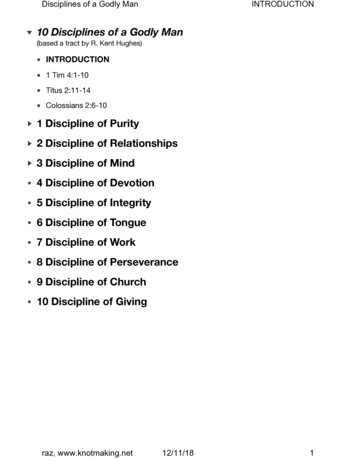
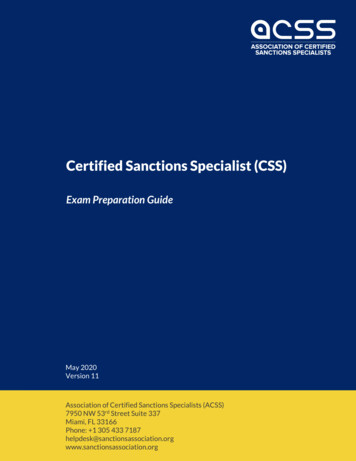
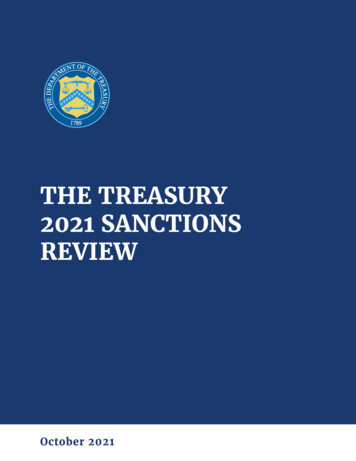
![Welcome [dashdiet.me]](/img/17/30-day-weight-loss-journal.jpg)
